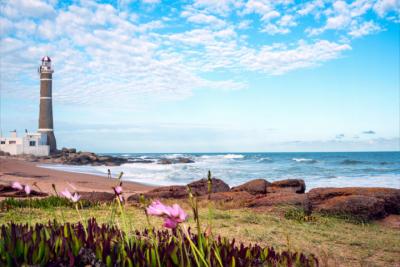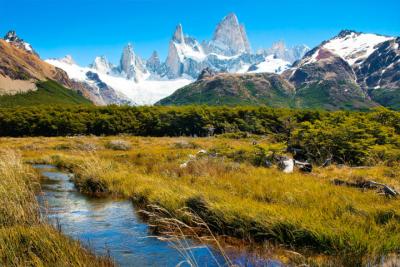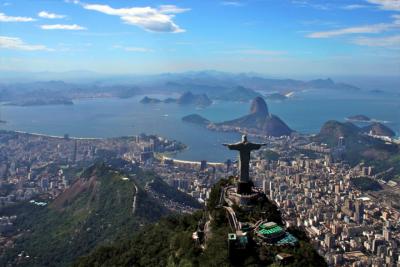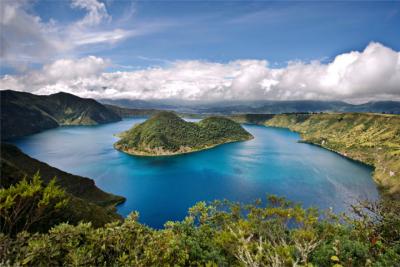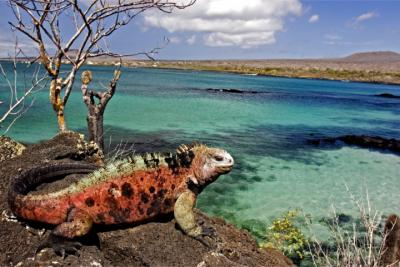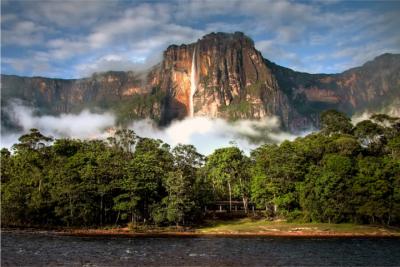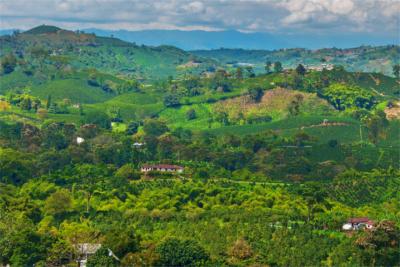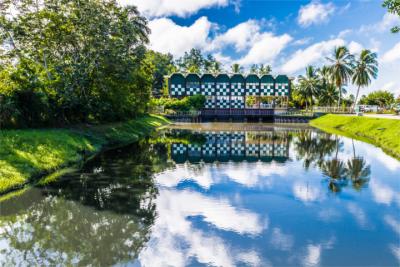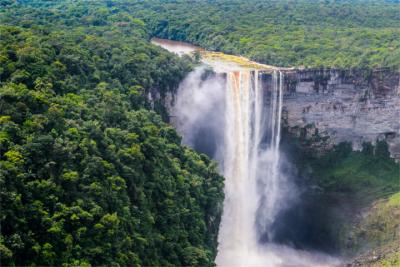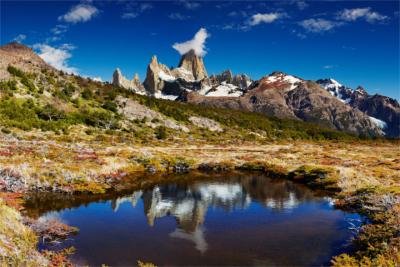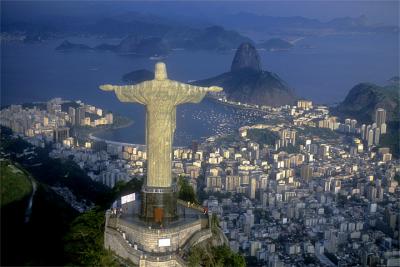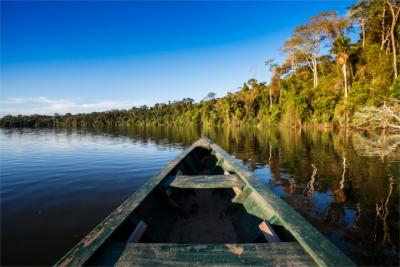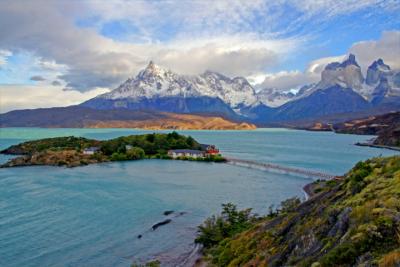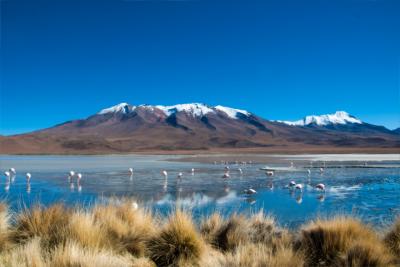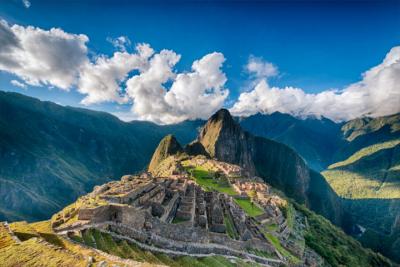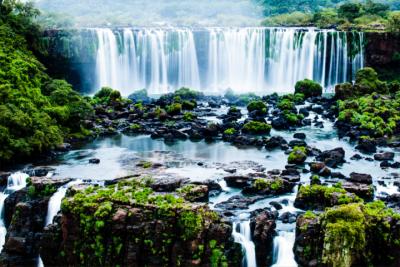Travel Offers
Travelmyne Featureprint
Distance
Brazil – Carnival, the Amazon and Beaches
Brazil seems to be dancing constantly. Its inhabitants emit a maximum of enjoyment of life, which culminates in the world-famous Rio Carnival in Rio de Janeiro. Furthermore, the country offers wonderful beaches and spectacular landscapes like the rainforest region of the Amazon Basin, which make Brazil a fascinating travel destination.

Geography - Almost half as big as South America
Brazil covers almost half (47 percent) of South America. It is the fifth biggest state on earth and the continent's most populous country with about 192 million inhabitants. In the north the gigantic Amazon crosses the flat landscape. South and north of the Amazon mountains chains alternate with plains of up to 2,800 metres of height. The climate is tropical with hot and humid weather in almost all parts of the country and dominated by warm temperatures between 25 and 30 °C on average throughout the year.

Nature - Gigantic rainforest, vast savannas and harsh mountains
The Amazon crosses the country from west to east. The major distributary of the best watered river on earth stretches for a length of almost 6.500 kilometres. It has about 200 tributaries and issues into the Atlantic Ocean with a delta of over 200 kilometres of width. A magnificent rainforest emerged around the Amazon, which constitutes the world's greatest forest region at one stretch. Over 2,500 different types of trees have been discovered here so far, the most mighty of which reach heights of up to 60 metres. Members of the extraordinarily diverse fauna are pumas, jaguars, river dolphins, monkeys, tapirs, sea cows and armadillos. The Pantanal region holds an even greater natural diversity. The landscape, which is characterised by fertile swamps and savannas, is an important retreat area for the endangered giant otter, for example. Brazil's mountains and highland, on the other hand, are mainly covered in grasses, shrubs and trees. Besides the big cats, the vast savannas are home to wolves, pampas deer or the greater rheas, which look like ostriches. The south of the country also consists of steppes. There are are vast coffee plantations near the coast and you find magical fine beaches at the seaside. With all this natural splendour Brazil is the most biodiverse country on earth - and many of the species living in the Amazon region have not even been discovered yet. When exploring this region, you may pass a wholly unknown plant or animal.

Natural sights - Experiencing the jungle, the Iguazu Falls and the Pantanal
A great way of diving into the impenetrable thicket of the Amazon region and gaining insights into the rainforest is a boat trip. A suitable starting point is the city Manaus. Nearby you find several jungle lodges which offer memorable overnight stays in Brazil's unique wilderness. A worthwhile attraction are the Iguazu Falls, which are embedded into a wonderful jungle landscape. The Iguazu River flows down a drop of up to 90 metres in 275 water columns at the border to Argentina. Several hiking trails lead visitors to this natural spectacle. You can also watch it from a boat or plane. A trip into the Pantanal is a must for lovers of nature. It is a great location for hiking and experiencing the unique, diverse flora and fauna first-hand – like the lively flying out of the swarms of parrots at the Lagoa of Araras. The plateaus Chapada dos Veadeiros and Chapada Diamantina display fascinating mountains, scenic rivers, waterfalls and small lakes as well as a wild, native nature. You experience Brazil's savannas in the Emas National Park. Impressive with regard to landscape are the "bed sheets of Maranhão". The term refers to the Lençóis Maranhenses, a desert area in which dunes of bright sand alternate with deep blue lakes and create a fascinating wavy pattern. Another natural attraction is the Rocas Atoll, which is part of the World Heritage. It is located 260 kilometres in front of Brazil's coast. This oval atoll, which mostly consists of corals and algae, is home to numerous sharks, turtles and dolphins. The Araguaia River offers great conditions for fishing. In addition, you can stay in floating hotels there. The Praia de Copacabana in Rio de Janeiro is the most famous example among Brazil's many magical beaches.

Culture - The mother country of samba and a significant football nation
Native American peoples have been living in the Amazon Basin for centuries. They created the Brazil Mound, which was used for funerals and ceremonies and has been preserved to the present day. Brazil belonged to Portugal during colonial times. The life of the population is characterised by music, which emits energy with its fast rhythms. You move to it by dancing temperamental dances like the samba, which originated in Brazil. Dancing comes naturally to Brazil's inhabitants. They show this at exuberant celebrations with the carnival events as the most lively examples. Playing football is another Brazilian passion. It brought them more championship titles in football than any other nation. That the country's inhabitants also have a sense for art was proven by artists like Aleijadinho, one of the most significant sculptors of the 18th century.

Cultural sights - Redeemer statue, cone sugar and modern metropolises
He spreads his arms and looks at the scenic bay of Rio de Janeiro in silence. The statue of Christ the Redeemer is 32 metres high and the country's most famous landmark. Close by you find the rounded Sugarloaf Mountain, which measures 395 metres. You can reach the top of the mountain by taking a cable car. A city, which perfectly embodies enjoyment of life, emerged in the middle of this beautiful landscape: Rio de Janeiro. People rarely celebrate as exuberantly and light-heartedly as in this seven million metropolis. Rio de Janeiro only wakes up in the evening, when it is filled with music, dance and boundless lust for life. The vivacious, Latin American temperament is most clearly shown during the world-famous Rio Carnival. Besides these lively events, travellers can visit the Botanic Garden, the old town or one of the beautiful churches such as the Cathedral of Rio de Janeiro (Portuguese: Catedral de São Sebastião). Brazil's biggest city São Paulo is also vibrant with activity. The metropolis with their 18 million inhabitants resembles an everlasting stream of people. Numerous influences are reflected in the city – American, European, Japanese and Russian are only a few examples. Holidaymakers who want to get to know the city's culture can visit the Teatro Municipal or the historical Jesuit college Patio do Colégio, for example. You can also go shopping here. A bit outside, the race course Interlagos allures motor sports friends from all over the world, for example during Formula One races. You can experience Brazil's African-American roots in Salvador da Bahia. Capoeira dancers, open-air parties, another world-famous carnival, many historical buildings and the Elevador Lacerda with its lifts, which transport people between upper and lower city, make the former centre of sugar trade a worthwhile destination. You perceive a completely different atmosphere in the capital Brasília. It was built in the shape of a plane on an uninhabited area from 1957 on. Brasília is known for its futuristic architecture as it is apparent from the mostly underground cathedral, the Pálacio do Planalto and the National Congress. Another example for the country's modern side is the Itaipu Dam, which is eight kilometres long and 200 metres high, and is operated by Brazil and Paraguay.

Experience - Feeling pure enjoyment of life at the carnival in Rio
Hot samba rhythms, thousands of exuberant dancers, extravagant floats and costumes – the Carnival in Rio de Janeiro cannot be surpassed. It is the heart of exuberant enjoyment. A visit to the Rio Carnival, which officially begins on the Friday before Ash Wednesday in February, is an extraordinary experience, which lets travellers feel - and join - the full intensity of the Latin American sense of life. In addition, clubs, discos and bars offer opportunities for going out. The country's cuisine is as varied and colourful as its population. Rice, brown beans and (grilled) meat are the bases of many dishes. You find these ingredients, for example, in the national dish fejoada, a Brazilian bean stew. The Brazilians love drinking caipirinha and beer. A journey on a historical train (for example with the Great Brazil Express) is a great way of getting in touch with country and people. Popular souvenirs are beach clothes, clay figures, carvings and rum (which is made from sugar cane).

Activities - From water sports to dancing lessons
Sunbathing, relaxing, swimming – you can do all that at Brazil's wonderful beaches. The idyllic coast also offers first-rate conditions for sporting activities, be it on the water (diving, surfing, water skiing) or at the beach (beach volleyball, jogging, walking). Football is played almost everywhere. Brazil's lush, wild nature also invites visitors to be active, from rafting to hiking to climbing. You can, for example, take part in survival tours, during which you do not only learn about nature but also how to climb the mighty trees of the rainforest or what is edible in the jungle. Popular activities are also roping down from rocks and waterfalls or in caves. In addition, Brazil offers great opportunities for those who want to take dancing lessons.

Information
The most important airports for tourists are those in Rio de Janeiro (GIG), São Paulo (GRU, VCP, CGH) and Manaus (MAO). You reach most places within the country by bus for little money. Those who want to move around more quickly can rent a car. Within cities, taxis are also a good option. The inhabitants speak Portuguese. There are several districts in Brazil which you should avoid as a tourist, especially the slums Favelas.
Due to its unique nature, especially in the Amazon Basin and the Pantanal, Brazil is the perfect destination for lovers of nature. Wonderful beaches, wild landscapes and countless opportunities of enjoyment make it the ideal country for travellers who want relaxing or active holidays.

